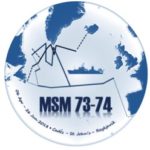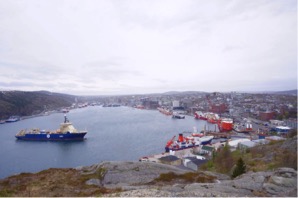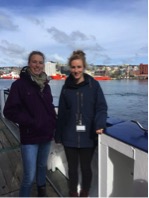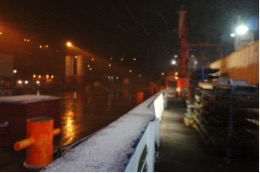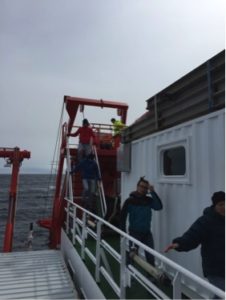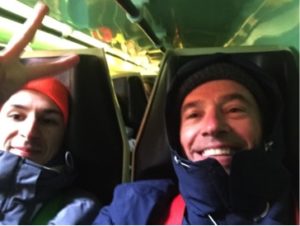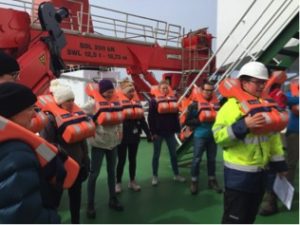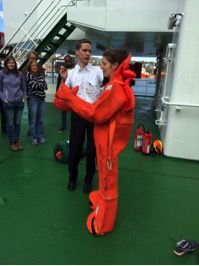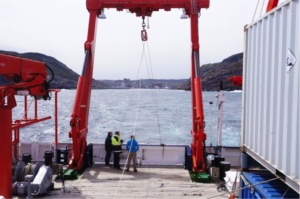by Nicolai Bronikowski, Memorial University
Blog Entry 1:
Summary:
And we are off! MSM 74 – the oceanographic cruise from St. John’s to Reykjavik is making its way to the Labrador Sea. In these 5 weeks a group of 21 scientists and 24 crew on board the German research vessel “Maria S Merian”, will brace the tough North Atlantic in the name of science. The mission: we will recover and re-deploy German, British and US moorings with measurement devices as well as take 80 CTD casts from the surface to the ocean floor to assist the scientists from the OSNAP program with their effort to estimate the Subpolar Overturning circulation and associated transport of heat and freshwater. In this blog we will detail some of the work being done, why it matters to oceanography and what life on board feels like. We hope you will enjoy reading this blog.
Day 1 – Day 3: Our journey begins in St. John’s – the capital of the easternmost province of Canada: Newfoundland and Labrador. St. John’s is a vibrant little city on the Atlantic coast inside a natural harbour of ragged rocks towering around the fjord. The night before putting out to sea snow fell and for a moment coated much of the city in a fine layer of fine white dust. It must have been an unusual sight to see snow in the end of May for most of our team arriving from places where summer already started. Our team consists of 21 scientists, 6 of which are bio-geochemists from Dalhousie University (Canada) and 15 physical oceanographers from GEOMAR (Germany), Memorial University (Canada), NOC (UK) and EPPS (France).
- St. John’s Harbour view from Signal Hill
- St. John’s Harbour view from Signal Hill
- Last night in St. John’s (May 24/25) and snow
After re-fuelling or bunkering as they say in nautical language, the ship’s ready for the voyage. The pilot boards the ship and helps the captain navigate safely into the open ocean. We all say goodbye to mainland until the end of cruise and are greeted by 2-4 meter swells. We began the journey with safety drills and figuring our safety equipment like entering the free-falling lifeboat and lifejackets.
- . No one wants to do this in real life. Let’s hope we won’t need the lifesaving equipment on this research cruise.
- Lifeboat training! We successfully cramped all 46 people on board into our freefall lifeboat within the prescribed time.
- Doing safety drill with lifejackets as well as …
- Introduction to the survival suit
- Last glance at St. Johns before the safety drills
After this was done it was time for our CTD test station (Station 27), just outside St. John’s. CTD stands for: Conductivity, Temperature and Depth sensor and is used to measure very precisely the temperature of the water. From conductivity, temperature and pressure, the salinity and density can be worked out using standardized equations for sea water. These variables are the most important physical variables captured on all ocean research cruises. However, our CTD cast has many more instruments attached such as an ADCP to measure current speeds, an oxygen sensor to measure dissolved oxygen, a flourometer to measure plant life activity, an altimeter to detect the distance to the seabed, and a UVP (underwater vision profiler) that takes high resolution pictures of living beings under water like plants, marine life and other particles. The CTD is attached to the so called rosette, which includes water bottles that can be closed at different depths and collect samples of sea water. These are then analyzed by the bio-geochemists for gasses such as oxygen or carbon dioxide as well as nutrients.
Everyone was present to learn about the different steps in taking a CTD cast and the necessary water sample preparations that needed to be done. Unfortunately, at this point, some of our scientific crew started to battle the effects of sea sickness and the ship’s doctor was doing his best encouraging us and gave us patches to counteract the sickness feelings. Now we are on our way to our first real mooring and CTD station site and we should arrive there this evening. Looking forward to what the day will bring.
